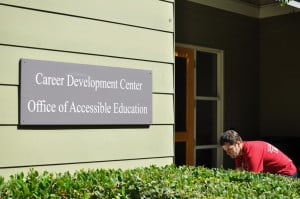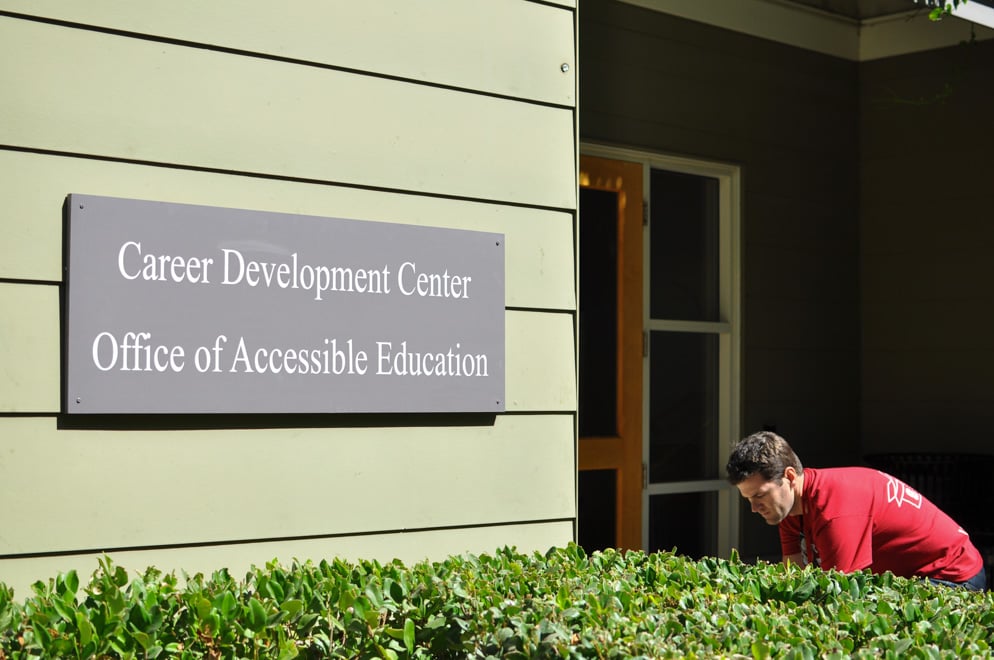
The Office of Accessible Education (OAE) has launched its search for a full-time learning strategist, a new staff position designed to address the particular needs of students with learning disabilities and Attention Deficit Hyperactivity Disorder (ADHD). This new position is meant to streamline OAE’s services, but has been met with skepticism from some students and staff.
The learning strategist will work with the Schwab Learning Center, a particular OAE service that was founded to support students with learning disabilities and ADHD. The position was created by Teri Adams, who became managing director of OAE after 17 years as a disability advisor.
In previous years, students with learning disabilities would meet with a learning specialist at the Schwab Learning Center to receive both legally mandated and additional “enhanced” services, which included individual advising on learning strategies and course-specific content tutoring.
A separate staff position, disability advisor, was responsible for supporting physically disabled students. Adams eliminated the learning specialist position in favor of a learning strategist after becoming managing director in June and hopes to fill the new position by winter quarter.
Susan Whitlow, a former learning specialist, was surprised by the elimination of the position, which she said left her unable to provide the special services that drew her to Stanford.
After a summer spent “trying to figure out a way to continue to provide the services to students [she] felt a commitment to,” Whitlow decided to resign on Sept. 11.
“[OAE] cares very much about the students but aren’t able to [care for them] because they’re absolutely inundated with the very short staffing that they’ve got without replacing those positions,” Whitlow said. “I feel that students aren’t getting their needs met, and if they are, it’s in a very delayed fashion.”
Structural changes
The new system relies on the exchange between the learning strategist and the disability advisor.
All students with disabilities — whether physical or hidden — will first consult with a disability advisor, who will be solely responsible for providing legally mandated basic services. These services include modifications to Stanford academic policy, such as a reduced course load, the provision of auxiliary services, like note-takers for hearing-impaired students, and other academic and physical accommodations.
If the advisor determines that a student may have a learning disability that requires special accommodation, they will refer the student to a learning strategist, who will assist the student in developing effective learning strategies.
Unlike the learning specialists of previous years, learning strategists will only be responsible for “enhanced service” provision. For instance, a learning-disabled student may now consult with two different OAE staff members: a disability advisor would help the student secure extended time on exams, and a learning strategist might advise on time management skills.
There are currently four full-time disability advisors at the OAE. In addition to her directorial duties, Adams is still providing disability advisor services.
Until a learning strategist is identified and hired, Lauren Solomon, a former learning specialist who became a disability advisor in June, is providing students with some learning strategies sessions.
The new system, Adams explained in an email to The Daily, will “more clearly delineate” the provision of basic and enhanced services.
“We’re just splitting apart who does what. We’re not changing what is done,” Adams said. “We may be able to provide even more services down the road.”
Adams said she created the new learning strategist position both to streamline service provision and reduce demands on a sometimes overburdened staff. Last year, two full-time learning specialists and a part-time staff member worked with learning-disabled students. Four disability advisors, including Adams herself, were responsible for the rest of the approximately 1,700 Stanford students that rely on OAE services.
The short-staffing, Adams explained, was partially due to circumstance — one disability advisor spent the year on medical leave. Still, staff and students felt the strain.
“The caseloads were very uneven,” Adams said. “I had 800 students last year, and some of the other people on the learning specialist side had less than 200. By splitting the enhanced services and the legally mandated services, I’m shooting for between three and four hundred students per person.”
Discontent with changes
One challenge with the new system is that a given student may need two points of contact, both the learning strategist and the disability advisor. Some students worry that this change will both create unnecessary complexity and make it harder for students and staff to form meaningful partnerships.
Paul Harrison ‘16, a student who receives accommodations from OAE for dyslexia, explained that his close personal relationship with his learning specialist (the old position) — “someone that could follow [him] throughout the entire experience” — has been integral to his success at Stanford. The specialist he spoke of was Whitlow, whom he worked with for the first three years of his undergraduate career. He credits Whitlow’s support with helping him stay at Stanford, even as he considered dropping out at the end of his freshman year.
Although the creation of the new learning strategist position is intended to make extra help more accessible for learning-disabled students, Harrison said that the change has had the opposite effect.
“Before, I would just go in and meet with Susan directly. The strategist and the advisor were one person,” Harrison said. “Now I have to go to [a disability advisor], ask her for an appointment, request for her to diagnose me in some way and then have her refer me to someone else, which could take several weeks.”
Whitlow, who worked with the Schwab Learning Center for four years, said she was attracted to the “high-touch” and deeply personal nature of the learning specialist job. She recalls not only working with current students to promote academic success but also reaching out to disabled Stanford alums and advising faculty on how best to support disabled students.
Whitlow also worried about students — new and returning — who rely on the Schwab Learning Center’s support.
“I think it’s a tremendous loss,” she said, expressing special concern for new freshmen who will enter Stanford without the previous support system. Whitlow wondered if students would run into serious academic difficulties because of the changes.
“I think it’s a concern because I know there are some students who told me that they made their decision to attend Stanford because of the level of support that we offered through the Schwab Learning Center services, and that was the deciding factor,” Whitlow added.
Harrison shared enthusiasm for his experience with the previous system.
“As someone who’s had a lot of academic struggles, you want someone to be a confidant or a mentor throughout your time at Stanford,” Harrison said. “I don’t think I would have succeeded here without the support Susan gave me through all those years.”
When he struggled with academic or personal challenges, he met with Whitlow several times a month and communicated with her regularly via email. On one occasion during his sophomore year, Harrison sought Whitlow’s help during the holiday break, and she counseled him via Skype.
“That was something completely outside of her duty of care,” Harrison said. “But there just isn’t that support anymore.”
Harrison praised the OAE staff members’ compassion and competence but cited “a lack of staff in general and a lack of resources” as major hindrances to the OAE’s efficacy.
“Just having that extra step means that, from a student’s point of view, I haven’t been able to access or check in with Lauren [Solomon, Harrison’s disability advisor] very much — both because she’s overwhelmed with cases and because there aren’t any learning specialists anymore,” Harrison said.
In Harrison’s view, the transition to a separation of services represents a change in the OAE’s character.
“They’re mechanizing and automating a process that was once personal,” he said, comparing the new system — in which students can go to “any strategist” for support rather than a specially assigned mentor — to the psychological services provided at Stanford’s Counseling and Psychological Services (CAPS).
“The reason that the Stanford OAE and the Schwab Center are so great is that they don’t follow the law line-by-line,” he added, referring to the fact that they provide services outside those mandated by federal law. “Talking about services in such a formulaic way isn’t going to gel when we’re talking about human issues.”
This year, Harrison has had one meeting with a disability advisor. He characterizes this quarter as “more of a stressed life” than he’s accustomed to, but holds more concern for entering students than for his own situation.
“At this point, I’m a senior, and I don’t really need the support as much as I used to, but it’s really sad for those who never had it,” he said. “I actually had this support for three years, and at the end of those three years, I really began to develop academically. I became a person that I’m proud of and that I’m happy about. If I were coming in now as a freshman, it would just be horrible.”
Harrison also fears that the specific needs of students with hidden disabilities, as opposed to physical disabilities, may no longer be adequately met. Shuttling both physically- and learning- disabled students to the same disability advisors, he said, fails to address the different needs of the two populations.
“For hidden disabilities, it’s easy to hide; it’s easy not to be fought for,” Harrison said. “It’s made me more alert to the fact that, to a certain extent, Stanford doesn’t want students with hidden disabilities.”
While Adams was unable to comment on any individual student’s situations for confidentiality reasons, she said that the majority of students registered with OAE have hidden disabilities, such as severe allergies, hearing impairments or chronic illnesses.
“In fact, it is a tiny minority of the students we serve whose disabilities are immediately apparent,” Adams said.
Moving forward
Despite wariness and criticism, Adams retains her optimism about the future of the OAE. In addition to restructuring service provision, Adams hopes to increase outreach to both students and faculty, provide new assistive technology for disabled students and “be part of the evolution” of the status of disabled college students.
“Many, many students say to me that we get it so much better than the other schools they talk to and that we have more experience in accommodating disabilities,” Adams said.
“We’re already a world-class program,” she added. “But we can always do even better.”
Contact Francesca Lupia at flupia ‘at’ stanford.edu.
